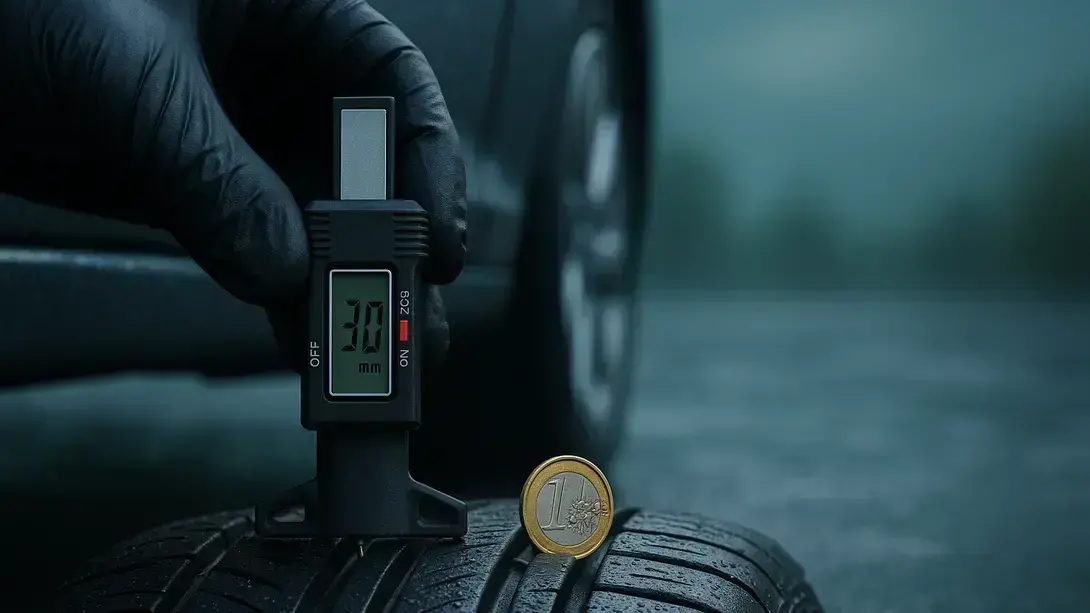Checking tire tread depth: How to measure correctly and avoid costly mistakes
Measuring tread depth: How to do it correctly, what the minimum values are, what fines you could face – and how tires affect the value of your vehicle
Tires are your only connection to the road – tread depth determines braking distance, aquaplaning, and thus safety and vehicle value. In this guide, you will learn how to measure tire tread depth, what minimum values apply, when it makes sense to replace tires, and what fines you may face if your tread is too low. Plus: How tires affect the price of your car when you sell it.
Measuring tread depth: how to do it correctly
Where on the tire do you measure tread depth?
- In the main tread grooves (not on the ribs/TWI).
- At several points across the tread (inside, center, outside) – uneven wear is common.
- Take at least three measurements per tire and note the smallest value.
What to use for measuring?
- Tread depth gauge (inexpensive, measures accurately).Münzentest (schnell, grob): Verschwindet bei der 1-€-
- Coin test (quick, rough): If the gold rim of a €1 coin is largely hidden, you are at approximately ≥ 3 mm. If you can see it clearly, it's time to measure more accurately.
Understanding TWI:
The small ridges in the grooves (tread wear indicators) are approx. 1.6 mm. If the tread and ridge are flush, you are at the legal limit – replace your tires at this point at the latest.
Minimum values & recommendations (cars, all-weather, motorcycles, trucks)
Minimum values & recommendations (cars, all-weather, motorcycles, trucks)
- Legal minimum tread depth (Germany/EU): 1.6 mm – applies to summer and winter tires, cars and, as a rule, also trucks/motorcycles.
- Recommendation for summer tires: Noticeably better wet performance from ~3 mm.
- Recommendation for winter/all-weather tires: Reasonable replacement from ~4 mm (sipes/snow traction deteriorate before this).
- Motorcycle tires: Legally usually 1.6 mm; replace earlier due to small contact area (safety reserve!).
- Trucks/vans: Legally 1.6 mm, in practice many operators set higher internal thresholds (e.g., more tread on steering axle/winter use). *Special seasonal rules may apply depending on the country/region
*Special seasonal rules may apply depending on the country/region.
Fines and risks associated with insufficient tread depth
Tread depths of less than 1.6 mm can result in a fine and a point on your license – and significantly more in the event of danger or an accident. In addition, braking distances are longer, aquaplaning is more likely, and directional stability is poorer. Even if 1.6 mm is legal, it is not safe – especially in wet conditions.
Tread depth & vehicle value: how it affects you
When buying, professionals look closely at tread depth, DOT age, uniformity, and tire type (summer/winter/all-weather).
- Four good tires (e.g., ≥ 5 mm, suitable for the season) improve the overall impression and can bring a noticeable price advantage.
- Tires < 3–4 mm or very old (> 6 years: check/replace) often lead to deductions because dealers factor in the cost of replacement.
- A mix (e.g., two summer, two winter, different brands) reduces the appeal.
Tip:
Before selling, measure honestly, note down the values, and include photos – or openly point out the need for replacement. This creates trust.
Measurement & replacement check: shortlist
- Measure: main tread grooves, several points, note down the smallest value.
- Replacement: summer ~3 mm, winter/all-weather ~4 mm.
- Legal: 1.6 mm is the absolute minimum.
- Check axle geometry/air pressure if there are significant differences between the inside and outside.
- Note tire age (DOT) – rubber hardens, even with a good tread.
FAQ – Frequently asked questions about tread depth
1) Where is tread depth measured?
In the main tread grooves, not on the TWI bars; at several points (inside/center/outside), the smallest value counts.
2) At what tread depth should summer tires be replaced?
Recommendation: from ~3 mm – better wet grip and shorter braking distances.
3) Can you still drive winter tires with a tread depth of 3 mm?
Permissible, but not recommended – winter tires provide significantly less traction below ~4 mm.
4) Is a tread depth of 5 mm permissible for winter tires?
Yes – absolutely fine if in good condition; also check the age of the tires.
5) Can you still drive tires with a tread depth of 3 mm?
Legally yes (above 1.6 mm), but borderline unsafe in wet conditions. Plan to replace them.
6) Where do you measure the tread depth on all-weather tires?
As with all tires: main tread grooves, several points. As a winter replacement, it is best to replace them from ~4 mm.
Brief summary:
You measure the tread depth in the main tread grooves at several points; the TWI bars indicate the legal minimum of 1.6 mm. Recommended: Replace summer tires from ~3 mm, winter/all-weather tires from ~4 mm – otherwise braking distance and aquaplaning risk increase. Uneven wear indicates air pressure/axle problems. Fresh, evenly worn tires with sufficient tread and the correct DOT increase safety and the value of the vehicle when selling.
Your fast track to selling – including tire check
Want to sell but unsure whether your tires have enough tread or will reduce the value? No problem: we will give you a fair valuation for your vehicle, collect it free of charge anywhere in Germany (even if it is not roadworthy) and transfer the money directly after collection.
Simply contact us via WhatsApp message or give us a call: +49 (211) 7306 1701.






